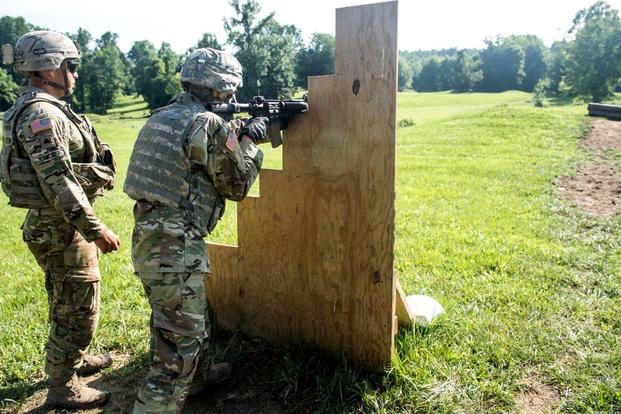FORT KNOX, Kentucky -- This summer, thousands of ROTC cadets are getting their first taste of shooting on the move during a new buddy-team live-fire course here at Advanced Camp.
Cadets run through the 100-meter course, using three-to-five-second rush, low-crawl and high-crawl techniques while their teammates shoot M4 carbines to engage targets with live ammunition from covered and concealed positions.
"This is the first time we have done buddy-team live fire," Lt. Col. Timothy Harris, professor of Military Science at Northern Michigan University, who serves as the officer in charge of the Buddy-Team Live Fire Committee, told Military.com.
"When they start off, they come up to barriers and they shoot standing or kneeling behind those barriers ... and then they crawl up to the lower barriers and they shoot from the prone."
About 30 sergeants from the 4th Infantry Division serve as walking safeties on the course.
"In addition to keeping the cadets safe and ensuring they keep the barrels pointed downrange ... they are also doing the on-the-spot coaching and mentoring ... and making sure they are keeping a constant rate of fire to support that buddy as they are moving to the next position," Harris said.
The new course is part of an effort to "align the training that officers are getting, coming out of their ROTC, to match more closely to what soldiers are getting, coming out of Basic Combat Training," he said, adding that the buddy-team live-fire course uses the same program of instruction as infantry One Station Unit training at Fort Benning, Georgia.
Each summer, about 7,000 cadets come to Knox for Advanced Camp, and another 3,000 come for the Basic Camp.
This summer, U.S. Army Cadet Command Camp extended Advanced Camp from 31 days to 37 to allow more time for additional basic rifle marksmanship, buddy-team live-fire and hand-grenade training, Maj. Gen. John Evans, commander of Cadet Command and Fort Knox, told Military.com.
"There is no provision for buddy-team live fire at many of the Basic Officer Leadership Courses," Evans said. "A lot of these kids, these young cadets, they will become lieutenants in the infantry or the armor and the engineers and they will get a chance to [do] this at BOLC. ... But if they are going to maybe the chemical corps ... or one of the logistics branches, they may not have the opportunity to do this type of training at BOLC."
In addition to the buddy-team live fire, cadets will get more basic rifle marksmanship training and be required to qualify on a standard Army 300-meter qualification course.
The new Advanced Camp also includes hand-grenade training, a skill not seen here "in quite some time," Evans said.
"They go through a hand-grenade familiarization, they go through hand-grenade assault range with training grenades, and then each cadet will have an opportunity to go down and throw two live fragmentary grenades," he said. "Throwing a hand grenade in Call of Duty is one thing. When somebody puts a live frag grenade in your hand for the first time -- that is a wake-up call."
Cadets do dry-fire practice training on a mock-up of the buddy-team course near their barracks area. The first day on the buddy-team range is done with blank ammunition. On the second day, cadets get 40 rounds each for the live portion of the course.
"They get 40 rounds -- it's two 20-round magazines so there is a magazine change in there ... under a little bit of pressure as opposed to being on the range," Harris said.
Some cadets move slower than others, he added.
"This is the first time many of these cadets have done any kind of fire and maneuver," he said. "We don't try to rush them through it -- slow is smooth, smooth is fast.
"If they do everything right, they only do it once."
After his run through the live-fire course, Cadet Connor Herbranson's body armor vest was plastered with mud.
The 21-year-old junior from Minnesota State University Mankato said he hopes to branch in the military police or engineers.
"It's a new experience having someone down range while you are firing," he said. "You really have to communicate and be listening for your buddy's commands."
The experience is intended to help cadets understand the most basic form of fire and maneuver on the battlefield, Evans said.
"The real idea with this is not just to be able to say, 'Hey, I have done everything my soldiers have done,' but it's also for them to have the confidence and the sets and reps to understand what it's like to have to be in an engagement with an enemy and be shooting and moving with somebody else," he said.
-- Matthew Cox can be reached at matthew.cox@military.com.
















